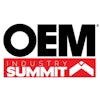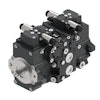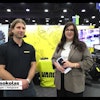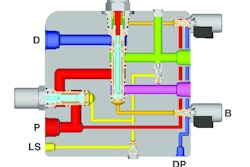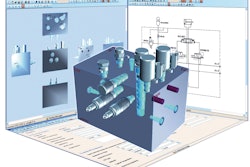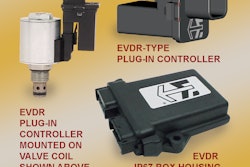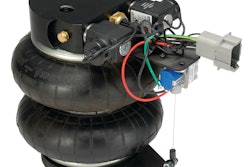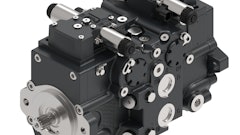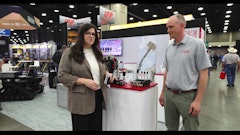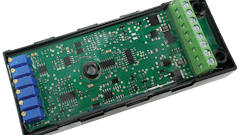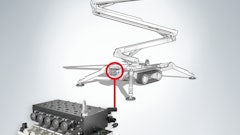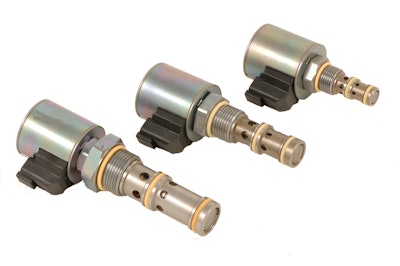
Multi-function valves, upgraded hydraulic circuit design software and engineered hydraulic control solutions that eliminate guesswork are just a few ways to streamline the process of designing hydraulic controls for mobile equipment. Post-pressure compensation allows available pump flow to be evenly distributed among all of the operating functions, even when total flow demand exceeds available pump supply, and work functions are at dissimilar working pressures.
Flow sharing is desirable whenever a machine needs to operate multiple work functions simultaneously. Traditionally, flow sharing circuits are achieved using spool-type directional control valves. However, a traditional spool valve constrains design engineers to use fixed meter-in/meter-out characteristics while the use of multiple cartridge valves does not. This allows the machine to be more productive and efficient by providing separate and independent meter-in/meter-out performance. The result is less wasted energy in the form of pressure drop and improved metering and flow control.
Cartridge valve-based directional control circuits are a superior alternative for controlling the motion of a hydraulic cylinder or motor. Although cartridge valves are installed in a centralized manifold, each valve can be fine-tuned independently, making it possible to optimize the meter-in/meter-out performance of one function without adversely affecting the other functions in the circuit. This offers unparalleled flexibility, as cartridge valves can be sized, tuned, and adjusted to match individual flow requirements in a single package. They are also easy and cost effective to service, since it is possible to replace a single cartridge valve without affecting the others in the system; whereas with a sectional type directional control valve, the valve stack would have to be removed and completely disassembled to service a single work function.
With the release of HydraForce’s (company information, 10055567) HSPEC family of multi-function electro-proportional cartridge valves, post-pressure compensated flow sharing is even further simplified. The HSPEC valve is actually three valves in one—an electro-proportional valve, a post-pressure compensator and a load-sense shuttle valve—and is available in three flow ranges (see chart on page XX).
Because the HSPEC is a multi-function valve, it replaces three individual cartridge valves in the manifold which reduces the space-claim of the manifold and total cost, since less material is used with fewer drillings and less machining time. Smaller manifolds allow the valving and control elements to be mounted closer to the actuators, increasing design flexibility and improving machine response time.
Cartridge valving applications
Multi-function HSPEC valves can be used in numerous applications to improve overall machine efficiency while optimizing the resolution and control of the actuators. In the schematic seen on page XX, an HSPEC cartridge valve is combined with three-position, four-way solenoid valves to control a motor or cylinder. This control scheme provides pressure-compensated flow control, precise metering characteristics and is easy to service. Previously, the only way to achieve post compensated flow sharing with cartridge valves would have been to use pressure compensators and load sense check valves at both the A and B work ports, resulting in a very complex circuit and assembly.
Bridge circuits
The ideal application for the HSPEC cartridge valves is the “bridge circuit.” The hydraulic bridge circuit was named for its similarities to the electronic Wheatstone Bridge. This type of circuit provides completely independent meter-in and meter-out motion control. The HSPEC provides flow control meter-in, while counterbalance valves provide pressure control meter-out. HydraForce’s bridge circuit requires only two coils per function. However, unlike contemporary solutions there is separate meter-in and meter-out control. The combination of flow control meter-in, pressure control meter-out provides ideal motion control for any hydraulic actuator and offers significant energy savings over traditional spool valve circuits.
The applications for the new HSPEC valve are nearly limitless. They can be used on anything from a boom/bucket control on a loader, which can benefit from the precise metering and load holding, to a telehandler, which also requires fine metering for stable lifting and smooth lowering, to agricultural harvesting machinery that has a multitude of control functions for cutting, shaking, conveying, and baling crops.
Electrohydraulic control adds more intelligence
The benefits of flow-sharing can be further enhanced with electronic control. HydraForce offers a highly flexible, yet simple to configure EVDR-0201 electronic controller (product information, 10057327) with onboard CAN capabilities that can be used to control one or two valve solenoid coils simultaneously. The controller can interface directly with main electronic control module (ECM) or can function on a stand-alone basis and communicate with other onboard components via its CAN channel. It can be mounted directly onto the valving hardware via a Deutsch™ mating connector, creating a more streamlined profile. The EVDR-0201 makes it easy to program ramp rates, maximum current and other parameters to fine-tune the control of the electrohydraulic cartridge valving.
Fast and easy circuit design
In addition to the HSPEC valve, HydraForce has created a library of engineered hydraulic control solutions that can speed up the process of creating hydraulic schematics. Called INTEGR8 (product information, 10964636), the new feature provides more than 40 commonly specified directional and flow control options that are easily integrated into a hydraulic circuit using the latest version of i-Design 4 circuit design software (product information, 10058327). Each combination of valves has been fully tested for compatibility and optimum performance. Direct-acting and pilot-operated control schemes are available, and each option can be further customized with additional valves to handle more functions as needed.
Each INTEGR8 option is depicted with combined ISO graphic symbols in a hydraulic schematic that can be dragged and dropped to start a control circuit diagram in i-Design manifold design software. This built-in library of INTEGR8 schematics eases and accelerates the design engineering process by eliminating guesswork. I-Design is available as a free download and allows for the export of hydraulic schematics into AutoCAD, the generation of STP models into Pro-E and the importing of schematics into Automation Studio for simulation.
For more information, visit www.hydraforce.com.

